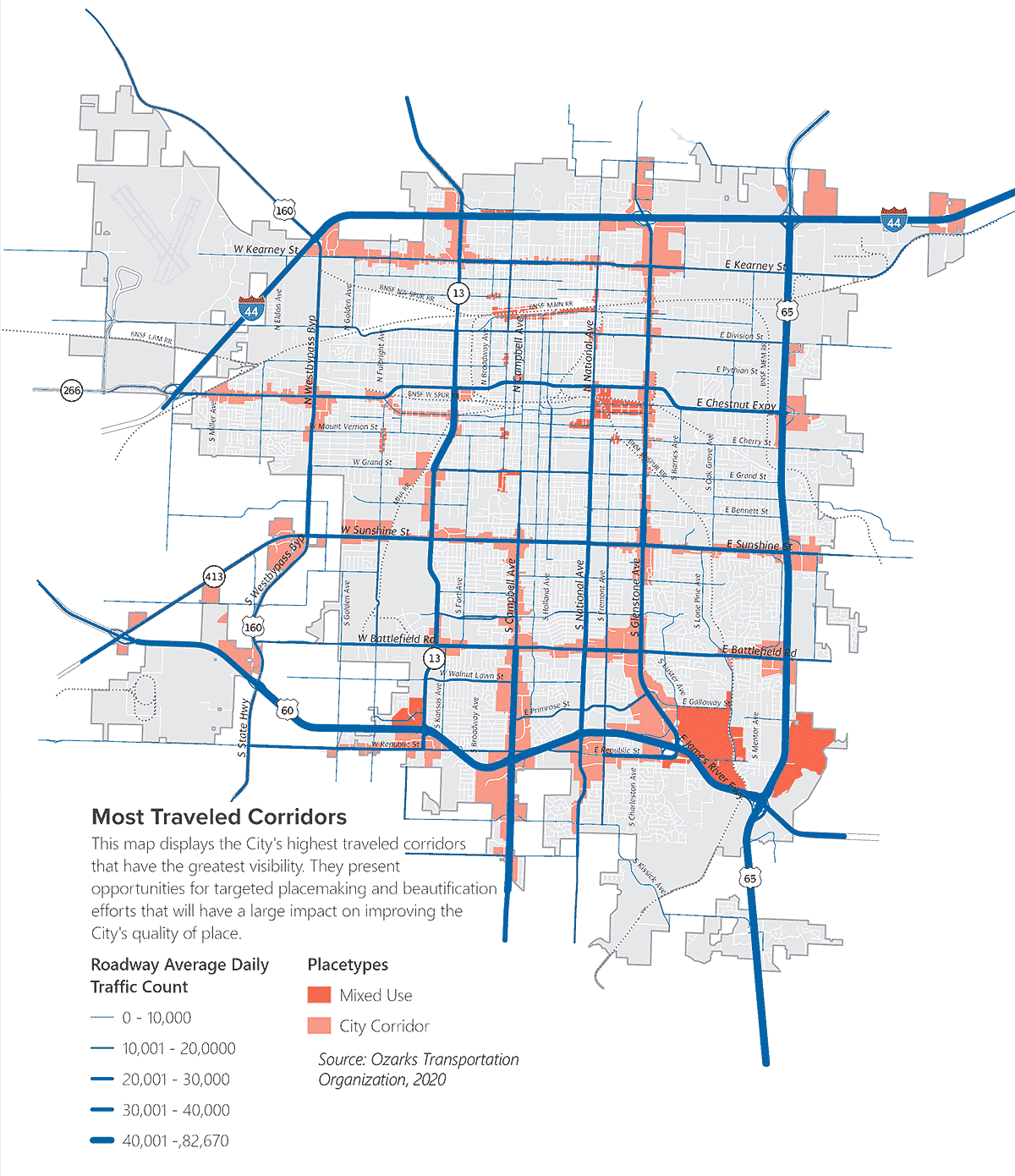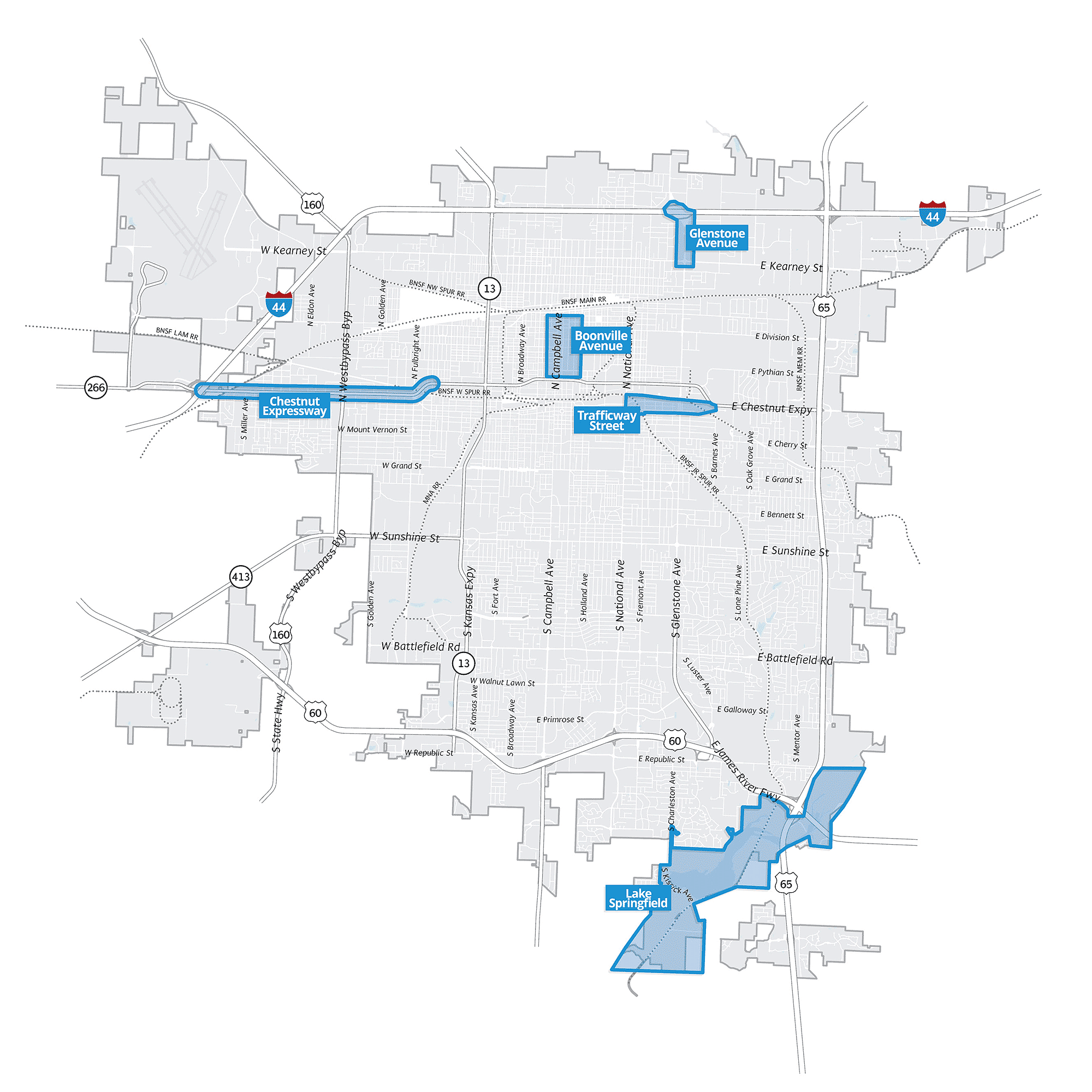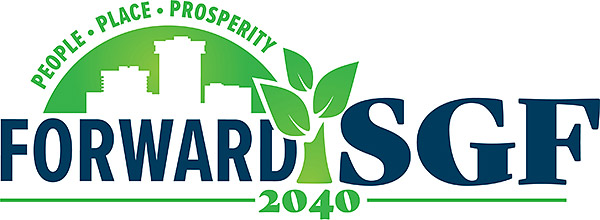Corridor Improvements
Reinvestment in and the beautification of Springfield’s commercial corridors was highlighted as a top initiative by the community during the public engagement process. The highest traveled corridors should be targeted for public and private improvements, as they would have significant impact in improving the City’s physical image, catalyzing attractive development, and building community pride.
Prioritizing Corridor Improvements
Corridors under the City’s jurisdiction should be prioritized to leverage the City’s greater control and flexibility in improvements to enhance quality of place. As some corridors are under the jurisdiction of the Missouri Department of Transportation (MoDOT) and Greene County Highway Department, future enhancements should be coordinated closely with respective transportation agencies.
Key corridors include, but are not limited to:
- Battlefield Street
- Campbell Avenue
- Chestnut Expressway
- Glenstone Avenue
- Kansas Expressway
- National Avenue
- Sunshine Street
It is important to note that investments should be balanced across the City to improve the overall image and vitality of Springfield in an equitable manner— this includes corridors facing the greatest disinvestment and those that are traveled the most, as well as those most used by GPS and navigation programs, such as Chestnut Expressway, Trafficway Street, or Glenstone Avenue. Development assistance should be provided to private developers and property owners in key redevelopment areas facing disinvestment in the City Corridor placetype to help offset cost of infrastructure improvements.

Subarea Plans
The City has entered a contract with a consulting firm to facilitate and draft an update to the Zoning and Development Code, which will provide the City with the regulatory framework essential to implement many of the recommendations outlined in the Comprehensive Plan that will impact expansion of uses and quality of place enhancements for (re)development projects located along key corridors in the city.
The City will begin the process of identifying new infrastructure projects along major corridors that will be funded over the course of the next 5 years. When possible, the corridor projects included will have a greater emphasis on quality of place. Forward SGF identified five areas of focus that exhibit significant potential for change, seen on the map below.

Grant Avenue Parkway
Chapter 6 – Growth & Annexation
- Goal 1. Managed Growth
- (1.1) Prioritize transportation corridors for annexation and infrastructure investment that will have a positive impact on improving the City’s physical image and catalyze attractive development
Chapter 7 – Housing & Neighborhoods
- Goal 2. Diversify Housing Choices
- (2.1) Support Context-Sensitive Higher Density Development
Chapter 9 – Transportation & Mobility
- Goal 1. Provide multimodal transportation options that are accessible and reliable for users of all ages, abilities, and backgrounds
- (1.3) Utilize Emerging Modes and Technologies
- Goal 3. Integrate Transportation and Land Use to Support Mobility and Placemaking
- (3.3) Enhance Community Character and Placemaking
- Goal 5. Establish Diverse Funding Strategies for Capital Improvements and Community Facility Enhancements
- (5.1) Explore Funding Alternatives
Chapter 10 – Infrastructure & Community
- Goal 3. Develop Infrastructure and Community Facilities in a Sustainable Manner
- (3.2) Identify, Promote and Protect Natural Infrastructure
- Goal 6. Foster public ownership and community identity towards Springfield’s infrastructure and community facilities as they continue to support the beautification of the city.
- (6.2) Beautify through Infrastructure
- (6.3) Multi-purpose infrastructure
Chapter 11 – Parks, Greenways, & Natural Resources
- Goal 4. Ensure Sustainable Growth and Environmental Stewardship by Conserving the City’s Natural Resources, while Fostering a Sense of Community Responsibility and Pride through Education and Immersive Experiences.
- (4.5) Identify Resilience Strategies
- (4.6) Preserve and Enhance the Urban Forest
Chapter 12 – Subarea Plans
- Glenstone Avenue Subarea Plan – Framework recommendations
- Trafficway Street Subarea Plan – Framework recommendations
- Chestnut Expressway Subarea Plan – Framework recommendations
- Boonville Avenue Subarea Plan – Framework recommendations
Chapter 13 – Downtown Plan
- Goal 2. Strengthen connectivity and circulation within Downtown, tying to surrounding neighborhoods and activity centers.
Chapter 15 – Implementation
- Implementation through regulation
- Implementation of interim amendments
To learn more about active transportation projects in Springfield, visit https://www.springfieldmo.gov/2243/Active-Projects.











